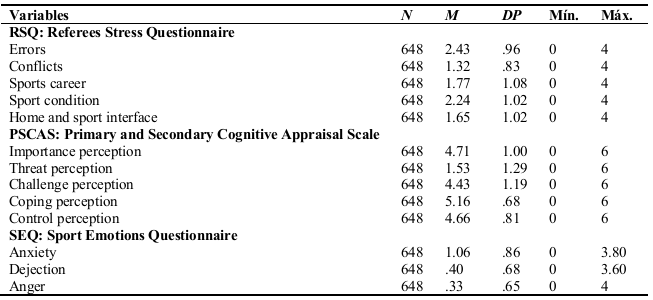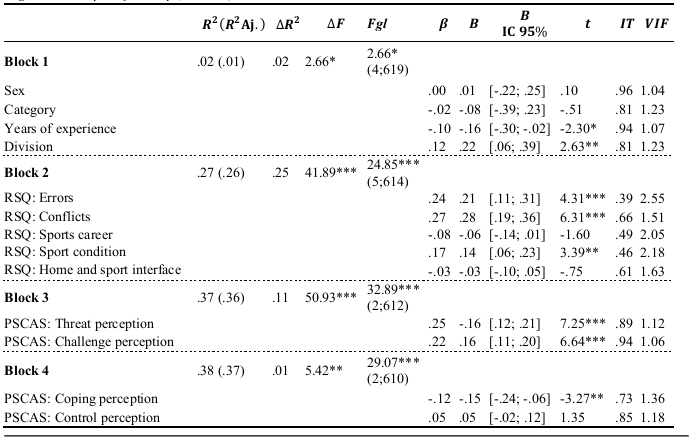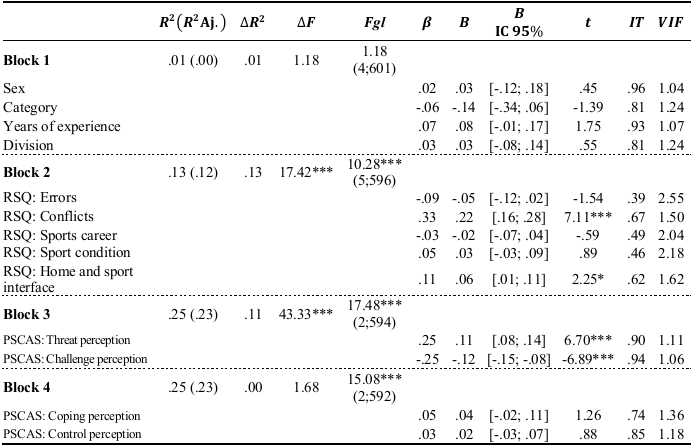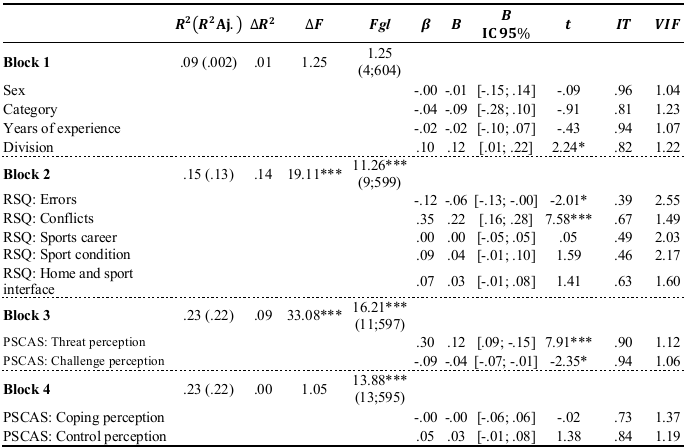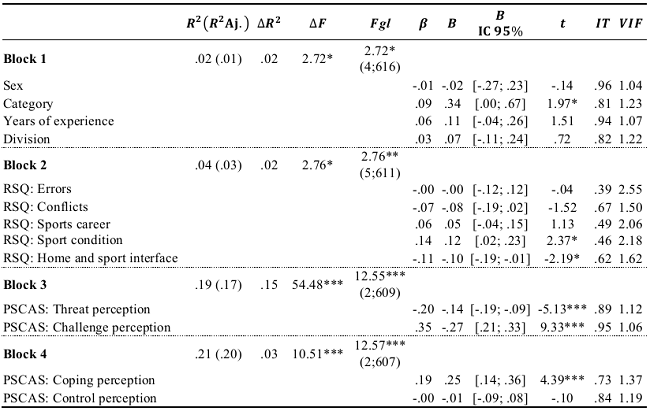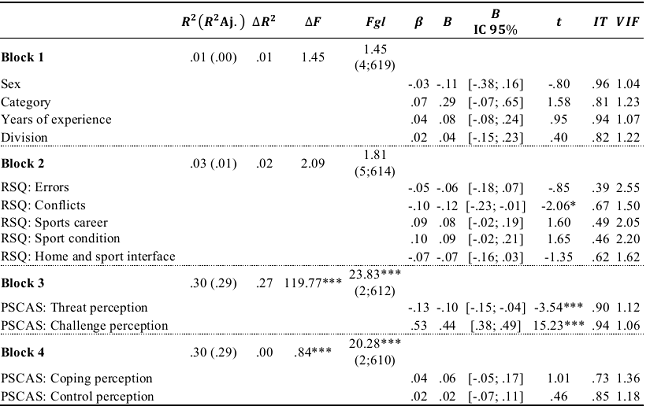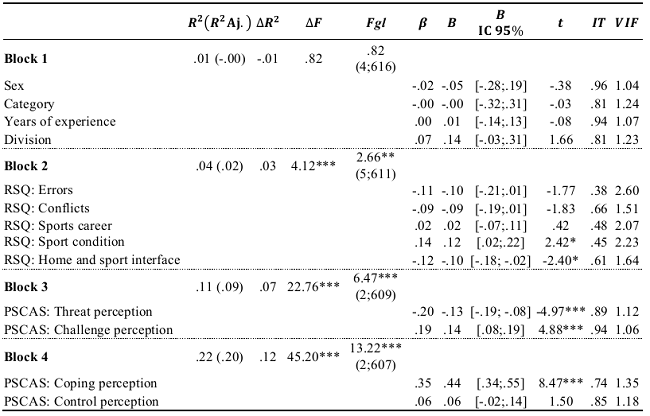INTRODUCTION
Referees assume an essential role in sports competitions because it involves ensuring that the sporting activity takes place safely according to the sporting rules (Rix-Lièvre et al., 2014). A referee has to make decisions (sometimes crucial) in a very short period of time and is highly exposed to criticism and pressure from players, coaches, spectators, and media (Gómez et al., 2019; Sors et al., 2019; Boschilia, Marchi Júnior, 2008; Guillén, Jiménez, 2001). Despite being a fundamental figure in sports, research on referees and their role is still limited (Anshel et al., 2014; Marrero, Gutièrrez, 2007).
Given their role and its characteristics, football referees are exposed to potentially stressful events before, during, and after a game (Ferreira, Brandão, 2012). If they do not know how to cope with stress successfully, they may suffer undesirable impacts on their emotions and performance (Ekmekçi et al., 2020). In fact, referees themselves seem to understand this relationship: in a qualitative study with eight FIFA referees, researchers found that referees recognized the importance of psychological factors for their performance, associating it with emotional and cognitive factors (Tobar et al., 2018). Additionally, studies indicate a correlation between perceived stress and physiological reactions, such as changes in heart rate (Castillo-Rodríguez et al., 2021), suggesting that referees with a better control of their stress tend to experience less physiological reactions and show better performance. Studies on referees' emotions and performance are, however, somewhat limited (Cipriano et al., 2019), since they do not seek to understand the psychological mechanisms that explain how stress relates to emotions and performance.
Considering these aspects, in this study we analyzed stress, cognitive appraisal, emotions, and performance perception altogether, using a “critical incident” methodology (refereeing a game in the next 24 to 48 hours), in order to understand how the referees adapt to a stressful situation. From a theoretical point of view, we adopted the cognitive, motivational, and relational transactional perspective of Lazarus (1991, 1999). According to this author, stress results from the interaction between the individuals and the environment, and occurs when an event is evaluated by the individuals as threatening or as exceeding their personal resources, which can be harmful to their well-being. Stress, therefore, tends to occur when individuals evaluate the demands of the environment as exceeding their capacities/resources to deal with them, thus placing central importance in the cognitive appraisal processes (Lazarus, 2000). Cognitive appraisal concerns the relevance that the individuals attribute to the stressful situation and the potential consequences for their well-being: the cognitive appraisal thus largely determines whether or not a situation is stressful for each person (Gomes, 2013), and is divided into primary and secondary (Lazarus, Folkman, 1984). Primary cognitive appraisal refers to the process by which the individuals analyze the situation and give it a personal meaning, namely if it is relevant to them, their goals, and their intentions about the situation (Gomes, 2013). Thus, if the situation is not important to the person, the experience of stress is conditioned; if it is important, it can be understood as either threatening or challenging for the individual. A threat appraisal indicates that the individuals perceive the situation as potentially damaging to their well-being, which increases the possibility of a worse adjustment to stress. On the other hand, a challenging evaluation means that the persons perceive the situation as beneficial to their well-being, increasing the likelihood of a positive adaptation to stress (Ritchie et al., 2017). Secondary cognitive appraisal refers to the analysis of the resources and skills that the person has to deal with the source of stress (Lazarus, 1999), that is, the way the person intends to deal with the stressful situation, which is influenced by the potential for confrontation (judgment on personal abilities to deal with the stressful situation) and perception of control (judgment on the ability to control the demands placed by the stressful situation) (Gomes, 2014).
The processes of cognitive appraisal influence the emotional reactions that occur during the adaptation to the stressful situation. Lazarus (2000) defines emotion as a psychological reaction that organizes ongoing relationships with the environment. For Deci (1980), emotions are reactions to a given stimulus, real or imagined. Lazarus and Folkman (1984) state that a high perception of threat and few resources to deal with the situation tend to impair the individual's adaptation and performance; on the other hand, a high perception of challenge and many resources to deal with the situation tends to facilitate the individual's adaptation and performance. Neil et al. (2011), in a study with athletes, corroborate this idea, noting that the positive evaluation of emotions can maintain the level of sports performance or even improve it; on the other hand, negative emotions can lead to poor sports performance. In turn, Neil and colleagues (2013), in a study with football referees, concluded that the evaluation of stress as threatening was associated with negative emotions that, consequently, negatively affected performance.
Thus, and taking into account the central role of cognitive appraisal in adapting to stress, it is possible that referees' sports performance may depend on how they evaluate the stress situation. Although the theory supports this notion, there are still few indications about how these psychological processes occur in practice in the context of refereeing. According to Lazarus (1991), the study of these stress adaptation processes must integrate stress, cognitive appraisal, and emotions as a whole. However, the existing literature tends to focus on a piecemeal analysis of these factors, which includes studies with referees. For example, Monteiro and Froeseler (2018) analyzed stress according to the coping strategies used by football referees, but did not analyze the emotions resulting from the use of these strategies or the impact on sports performance. Likewise, Johansen and Haugen (2013) sought to understand whether stress levels affect the sports performance of football referees, but did not consider the cognitive appraisal processes. Despite these studies producing important data, Lazarus (1991) warns of the importance of analyzing those variables as a whole, despite the methodological complexity that this implies (Gomes, 2013). In order to overcome this limitation, this study analyzes these variables in an integrated way, using a critical incident methodology (Flanagan, 1973): the referees answered questionnaires that evaluated stress before their next game (24 to 48 hours), including the cognitive appraisal processes, the emotions felt in relation to the game, and the perception of their performance for the game. Thus, we tried to understand how football referees adapt to stress, considering, in an integrated manner, the stress factors, the cognitive appraisal processes, the emotional reactions, and their performance perception. In summary, the objectives of this study are to: 1. Analyze the referees' psychological experience before a game and; 2. Analyze the predictive value of stress and cognitive appraisal on emotions and performance perception of referees before a game.
MATERIAL AND METHODS
Participants
This study included 708 football referees, with 646 (91.2%) males and 62 (8.8%) females, aged between 18 and 53 years (M = 26.81; SD = 7.32). Referees assumed their functions in a variety of football levels according athletes' ages: under-12 (n = 29; 4.1%), under-14 (n = 43; 6.1%), under-16 (n = 54; 7.6%), under-18 (n = 92; 13%), and senior (n = 490; 69.2%). They referee games at different levels: district (n = 532; 75.1%), national (n = 162; 22.9%), professional (n = 13; 1.8%), and international (n = 1; 0.1%). The number of years refereeing in official competitions varied between 1 and 30 years (M = 7.13; DP = 5.62).
Instruments
Socio-demographic Questionnaire. This questionnaire collected socio-demographic information, such as sex, age, number of years of experience in official competitions, category, and competitive division where the referee arbitrates. Category increased according to distinct classes, from lower classes (young athletes and district competitions) to higher classes (adult athletes from national competitions).
Referees Stress Questionnaire (RSQ; Gomes et al., 2021). Evaluates sources of stress related with the activity of refereeing in sports. This instrument is composed of 20 items, which are divided into five subscales: (a) errors (α = .90, in this study): referees' stress regarding failing or making serious mistakes during games; (b) conflicts (α = .81, in this study): referees' stress related to interpersonal conflicts during games and the need to assume disciplinary actions to control incorrect behaviors of others; (c) sport condition (α = .89, in this study): referees' stress related to feelings of lack of preparation to arbitrate the next game; (d) sports career (α = .85, in this study): referees' stress in receiving negative evaluations from the official observers about their performance and the impact that it can have in their career; and (e) home and sport interface (α = .84, in this study): referees' stress related to the interference between the sports activity and their personal and family lives. Items are answered on a 5-point Likert-type scale (0 = no stress; 2 = moderate stress; 4 = too much stress). The score is obtained by averaging the items in each scale, meaning that higher scores correspond to higher levels of stress. The psychometric properties of this instrument were acceptable in this study: x2(158 g.l.) = 613.176, p < .000; x2/df = 3.881; RMSEA = .067, C.I. [.061; .072]; SRMR = .06; CFI = .942; TLI = .931 (Bentler, 2007).
Primary and Secondary Cognitive Appraisal Scale (PSCAS; Gomes et al., 2017). Evaluates primary and secondary cognitive appraisal of individuals regarding their professional activity (in the case of this study, related to the referees' activity). Primary cognitive appraisal is divided into three subscales: (a) importance perception (α = .91, in this study): evaluation of referees' activity as personally significant and important for their wellbeing; (b) threat perception: (α = .85, in this study): evaluation of referees' activity as disturbing and negative for their wellbeing; (c) challenge perception (α = .89, in this study): evaluation of referees' activity as stimulating and exciting for their wellbeing. Secondary cognitive appraisal is divided into two subscales: (d) coping perception (α =.88, in this study): evaluation of personal resources to deal with the situation's requirements and demands; and (e) control perception (α = .67, in this study): evaluation of personal control over the referees' activity. This scale included 15 items, three per scale. The items are answered on a seven-point Likert-type scale (0 = Is not at all important to me; 6 = Is very important to me, for work importance). The score is obtained by averaging the items in each scale, meaning that higher scores correspond to higher levels of cognitive appraisal. The psychometric properties of this instrument were acceptable in this study: x2(80 g.l.) = 253.661, p < .000; x2/df = 3.171; RMSEA = .058, C.I. [.050; .066]; SRMR = .04; CFI = .968; TLI = .958 (Bentler, 2007).
Sport Emotions Questionnaire (SEQ; Jones et al., 2005; translated by Gomes et al., 2021). Evaluates five emotions in sports activity: (a) anxiety (α = .84, in this study), (b) dejection (α = .87, in this study); (c) anger (α = .86, in this study); (d) excitement (α = .72, in this study); and (e) happiness (α = .92, in this study). The instrument has 22 items distributed by the five dimensions. The items are answered on a five-point Likert-type scale (0 = Nothing and 4 = Extremely). The score is obtained by averaging items in each scale, meaning that higher scores correspond to higher levels of emotions. The psychometric properties of this instrument were acceptable in this study: x2(198 g.l.) = 791.095, p < .000; x2/df = 3.995; RMESEA = .068, C.I. [.063; .073]; SRMR = .07 CFI = .934; TLI = .923) (Bentler, 2007).
Sports Performance Perception Questionnaire (SPPQ) (Gomes et al., 2019). Evaluates sports performance perception, both at individual and collective levels. For this study, only the individual level was used (α = .89, in this study), which refers to the referees' perception of achieving their personal goals in the next game. It consists of five items answered on a five-point Likert-type scale (0 = I do not agree and 5 = I totally agree). The score is obtained by averaging the items in each scale, meaning that higher scores correspond to higher perception of individual sports performance. The psychometric properties of this instrument were acceptable in this study: x2(3 g.l.) = 5.244, p < .155; x2/df = 1.748; RMSEA = .034, C.I. [.000; .081]; SRMR = .01; CFI = .999; TLI = .996) (Bentler, 2007).
All instruments were adapted to the referees' activity, namely the instructions were reformulated by using the term “referee” instead of “athlete”, which is the common term in these measures. Likewise, and given the nature of the “critical incident” methodology of this study, the referees were instructed to fill the assessment protocol by thinking of their next game.
Procedure
This study was approved by the Ethics Committee of the authors' university (SECSH 016/2015) and was conducted in accordance with the Declaration of Helsinki. Then, District Delegations of Referees were contacted in order to obtain the referees' contacts. Referees were asked to participate in this study after explaining the goals and methodology of data collection. Evaluation protocols included informed consent with all the study's necessary information. After filling out the informed consent, the participants answered the questionaries 24h or 48h before the next game, typical in a critical incident methodology. We delivered 720 evaluation protocols to referees and 708 were returned (return rate of 98.3%).
Statistical analyses
Statistical analysis was done on IBM SPSS Statistics (version 26). In order to explain adaptation to stress in referees, we selected participants who evaluated the task of refereeing the next game as an important event for them. Following conceptual and empirical indications about adaptation to stress (Gomes, 2014; Gomes et al., 2017) we used the PSCAS scale of importance to exclude referees that did not attribute importance to the next game (values equal to or less than two points), eliminating 60 participants, with the final sample totaling 648 referees. After removing these participants, we proceeded with the analysis. The first step of data analysis was describing the experience of adaptation to stress in referees by analyzing, in a descriptive way, the variables in the study (first goal of this study). For the prediction of emotions and perception of individual performance (second goal), we used a linear hierarchy regression analysis (enter method), inserting the variables according to the theoretical explanation of adaptation to stress (Gomes, 2014; Lazarus, 1991): (a) personal and sport variables, (b) stress factors, (c) primary cognitive appraisal, and (d) secondary cognitive appraisal.
RESULTS
Descriptive Analysis
Firstly, we analyzed the descriptive values of the variables in the study (see Table 1). Before the game, the referees experienced higher levels of stress-related to errors and sport condition. Coping perception was the dimension with higher values in terms of cognitive appraisal. Happiness and excitement were the emotions most felt by the referees and they had high expectations regarding their individual performance perception.
Regression Analysis
Regression analysis was performed by blocks. In block 1, we introduced one personal variable (sex) and three sports variables: category (that increases in terms of competitive level), years of experience, and competitive division (that increases in terms of geographic visibility, from district to international scenarios). In block 2, stress factors were introduced. In block 3, we introduced primary cognitive appraisal. In block 4, we introduced secondary cognitive appraisal.
Starting with anxiety, in block 1, the number of years of professional experience and the competitive division were significant predictors of anxiety, explaining 1% of the variance. In block 2, stress related to errors, conflicts, and sports condition were significant predictors of anxiety, and the model increased to explain a total of 26% variance. In block 3, both perceptions of threat and challenge were significant predictors of anxiety, and the model increased to a total of 36% variance. In block 4, the coping perception was a significant predictor of anxiety, and the final model explained 37% of the variance. So, anxiety was explained by fewer years of experience in refereeing, being a referee in the highest competitive division, having higher stress related to errors, conflicts, and sport condition, and having a higher perception of threat and challenge, and having a lower coping perception (see Table 2). In this analysis, we eliminated two outliers.
Regarding dejection, block 1 was not significant. In block 2, stress related to conflicts and home and sport interface were significant predictors of dejection, and the model explained 12% variance. In block 3, both perceptions of threat and challenge were significant predictors of dejection, and the model increased to a total of 23% variance. Block 4 was not significant. Therefore, dejection was explained by having higher stress related to conflicts and the home and sport interface, and by having a higher perception of threat and a lower perception of challenge (see Table 3). In this analysis we eliminated 20 outliers.
Regarding anger, in block 1, the competitive division was a significant predictor of anger, although the explained variance was residual. In bock 2, stress related to errors and conflicts were significant predictors of anger, and the model explained 13% variance. In block 3, both perceptions of threat and challenge were significant predictors of anger, and the model increased to explain a total of 22% variance. Block 4 was not significant. Thus, the anger felt by referees was explained by refereeing in the top competitive division, by feeling less stress related to errors and feeling more stress related to conflicts, and by having a higher perception of threat and a lower perception of challenge (see Table 4). In this analysis we eliminated 20 outliers.
Regarding excitement, in block 1 the variable category was a significant predictor of excitement with a total of 1% variance. In block 2, stress related to the sports condition and the home and sport interface were significant predictors of excitement, and the model explained a total of 3% variance. In block 3, both perceptions of threat and challenge were significant predictors of excitement, and the model increased to explain a total of 17% variance. In block 4, coping perception was a significant predictor of excitement, and the final model explained 20% variance. Thus, excitement was explained by refereeing in higher competitive levels, by feeling greater stress related to the sports condition and lower stress related to the home and sport interface, by having a lower perception of threat and a higher perception of challenge, and by having a higher perception of coping perception (see Table 5). In this analysis we eliminated three outliers.
Regarding happiness, block 1 was not significant. In block 2, stress related to conflicts was a significant predictor of happiness, and the model explained a total of 1% variance. In block 3, both perceptions of threat and challenge were significant predictors of happiness, and the model increased to explain a total of 29% variance. Block 4 was not significant. Therefore, happiness was explained by lower stress related to conflicts and by having a lower perception of threat and a higher perception of challenge (see Table 6). In this analysis we eliminated two outliers.
Finally, regarding individual performance perception, block 1 was not significant. In block 2, stress related to the sports condition and to the home and sport interface were significant predictors of individual performance, and the model explained 2% of variance. In block 3, both perceptions of threat and challenge were significant predictors of individual performance, and the model increased to explain a total of 9% of variance. In block 4, coping perception was a significant predictor of individual performance, and the final model explained 20% variance. Thus, perception of individual performance was explained by higher stress related to sports condition, less stress related to the home and sport interface, by having a lower perception of threat and a higher perception of challenge, and by having a higher perception of coping perception (see Table 7). In this analysis we eliminated five outliers.
DISCUSSION
Regarding our study's first goal, descriptive data point out as major stressors the possibility of making errors in the next game and feelings of bad sports condition to referee the next game. Referees showed high levels of coping perception and low levels of threat perception, and the two major emotions were positive (happiness and excitement), although we should mention the third major emotion was anxiety; they were also very positive regarding the possibility of having better individual performance perception. All in all, referees felt concern related to errors and sports condition, but they seem to assume a positive perspective regarding their next game. The existing literature also points to these factors as contributing to a greater experience of stress in referees. Gillué and collaborators (2018) found that, among other factors, making mistakes was the cause of most stress for football referees. These results appear to be consistent across sports. In a study with rugby referees, Hill and colleagues (2016) found that one of the five major stress factors were “performance errors”. These authors suggested that this may be in part due to the scrutiny referees suffer, along with the pressure they feel from all sports agents. Likewise, in a study with basketball referees, Ritchie et al. (2017) found that officials experienced high levels of fear of failure, especially during games that are tied or with a close score.
Regarding the second goal of our study, data is more complex to interpret. We should highlight three aspects. First, having less experience in the referee activity and refereeing in the top levels of the competition seem to increase the possibility of anxiety and even anger, but seem also to increase feelings of excitement. Thus, increasing the level of competition can elicit both negative and positive emotions in referees. There are indications that less experienced referees report more anxiety and anger than their more experienced counterparts (González-Oya, Dosil, 2004; Neil et al., 2013), with some studies noting that experience is directly positively correlated with the referees' official scores (Mendes et al., 2021). These authors explain this result with the fact that experienced referees have already encountered many stressful situations during the game, and thus have more or better coping skills that lead them to experience less anxiety and anger when compared with rookie referees. This hypothesis is also presented in Guillén and Feltz's study (2011), in which the authors found that the perceived efficacy of past performance impacts a referee's perception of future efficacy. It appears that this confidence in their refereeing skills helps them in making less negative cognitive appraisals, thus lowering anxiety and anger levels. Regarding excitement, Hill et al. (2016) also mention that big games elicit feelings of excitement in referees. Our results of top-level referees experiencing more excitement could be related to the fact that these referees have more big-game opportunities than referees in lower divisions. Concomitantly, for referees with less experience all games can be perceived as “big games”, since they typically have not yet had the chance to referee many games. However, this is only a possible explanation that must be fully explored in the future.
Second, stressors were major predictors of negative emotions, most notably anxiety, and they were weak predictors of positive emotions of excitement and happiness. Specifically, aspects related to errors, conflicts, and sports condition were predictors of anxiety; conflicts and home and sport interface were predictors of dejection; and errors and conflicts were predictors of anger (although errors assumed an unexpected negative relationship with anger). From all these predictors, errors and mostly conflicts represent the strongest predictors of negative emotions in referees before a game. The literature corroborates most of these results (e.g., Hill et al., 2016), with unpleasant emotions being highly predicted by stress factors such as errors and conflicts. This may occur due to a negative evaluation of the stressful situation that makes referees experience higher levels of negative emotions, such as anger and dejection.
Third, the processes of cognitive appraisal, mainly the primary cognitive dimensions of threat and challenge, were very important to explain the referees' emotions (both negative and positive). Specifically, increases in both challenge and threat appraisals explained anxiety, and increases in threat and decreases in challenge appraisals explained dejection and anger; on the contrary, decreases in threat and increases in challenge appraisals explained both positive emotions of excitement and happiness. It is difficult to contrast these results with research done with referees, but studies with athletes corroborate these findings. For example, Neil et al. (2011) found that threat appraisals led to an experience of anxiety and anger in both elite and non-elite athletes. Additionally, Hill et al. (2016) reported that professional referees who assumed more challenging appraisals experience more excitement. Finally, Liu et al. (2021) found that athletes that experienced some degree of anxiety showed more attentional control and thereby performed better. In our results, it is also relevant to refer that the secondary cognitive appraisal of coping perception was important to explain anxiety (lower values corresponded to higher anxiety) and excitement (higher values corresponded to higher excitement), both of which have been previously reported in other studies (e.g., Neil et al., 2013). Finally, cognitive appraisal was the main predictor of individual performance perception, with higher perceptions of challenge and coping perception and lower levels of threat perception corresponding to higher perception of individual performance. Neil et al. (2013) also pointed out to the role of cognitive appraisal, sustaining that it affects not only performance perception but also the referees' objective performance in a match.
CONCLUSIONS
Our results highlight the importance of stressors in explaining the negative emotions of referees, and the importance of cognitive appraisal to explain both the negative and positive emotions of referees and their perception of individual performance.
PRACTICAL APLICATIONS
Several practical implications can be drawn from these study's results. Regarding stress sources, the feeling of being in a poor sports condition could be helped by ensuring referees have access to adequate training facilities, along with professionals that can help train their physical condition, which would likely also diminish the fear of making mistakes.
This study confirmed the crucial role of cognitive appraisal in the experience of stress and its relationship with performance perception. These results should therefore be applied to practice, namely in psychology interventions aimed at improving life skills in referees. Specifically, referees would benefit from learning stress management skills and techniques to increase their perceived control and coping. Moreover, referees should learn how to evaluate a stressful situation as more challenging than threatening, and thus elicit more positive emotions. This would enable them to better adapt to the stressful situations that are an integral part of their profession, thereby achieving better performance and successfully adapting to stress. Interventions such as these should also rely on more experienced referees and those at the top of their careers, who seem to possess certain skills to deal with stressful situations, to teach less experienced professionals.













